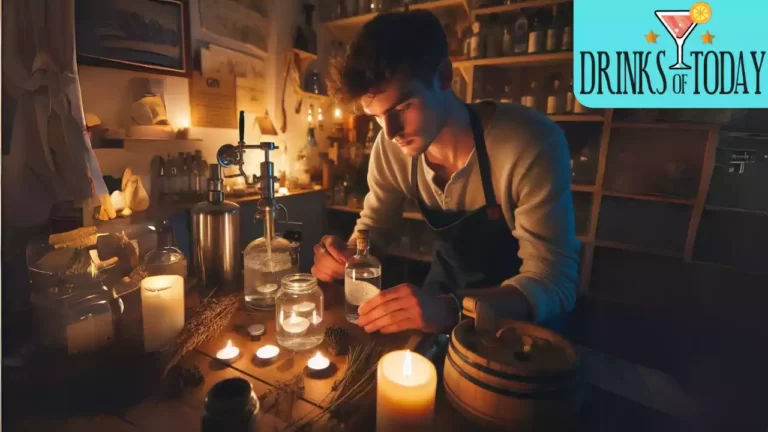The Art of Distilling Gin at Home: A Step-by-Step Guide
In a world where store-bought gin is as easy to come by as a cold day in Antarctica, I’ve chosen the path less traveled: crafting my own spirit.
It’s an art form, really, distilling gin at home. I’ll guide you through the intricate ballet of turning simple ingredients into a complex, aromatic elixir.
We’ll start by demystifying the process, then I’ll help you gather the right equipment, ensuring precision in every step. You’ll learn to curate a blend of botanicals that’ll make your taste buds dance with anticipation.
With my expertise, you’ll navigate the distillation process, transforming a clear liquid into a masterpiece of flavor and character.
Let’s embark on this creative journey together, where I’ll be your mentor in the timeless craft of home-distilled gin.
Continue Reading to Understand These Key Points:
- Precision and creativity are crucial in the gin distillation process.
- The selection and balance of botanicals, such as juniper, coriander, and citrus peels, are important for flavor.
- Column stills are preferred for a more refined spirit.
- The distillation process involves monitoring temperature, collecting the heart of the run, and discarding the heads and tails to ensure a high-quality final product.
Understanding Gin Distillation
I’ll begin by explaining the process of gin distillation, which is the crucial step in crafting a unique and flavorful spirit at home. As an avid home distiller, I’ve learned that precision and creativity are paramount.
The journey starts with a base of neutral grain alcohol. It’s essential that it’s high-proof and as flavorless as possible to ensure a clean canvas for the botanicals.
I carefully select and balance my botanicals—juniper being the star. It imparts that signature piney flavor that defines gin. I often experiment with coriander, citrus peels, and other aromatics to create a complex, nuanced profile.
These botanicals are either macerated in the alcohol before distillation or introduced into the still’s vapor path, allowing the hot alcohol vapors to extract the flavors.
I use a column still for a more refined spirit. I monitor the temperature meticulously, as it’s critical for separating the desired flavors from any undesirable compounds.
The first liquid, the ‘heads,’ contains volatile substances and is discarded. The ‘heart’ that follows is the smooth, aromatic gin I’m after. I end the process by discarding the ‘tails,’ which can have a harsh taste.
Each run is an alchemy of science and art, yielding a sip of liquid craftsmanship.
Assembling Your Equipment
Before diving into the distillation process, I must have all the necessary equipment assembled and ready to use. This includes a reliable still, which can be a simple pot still for beginners or a more advanced column still for those seeking greater control over the final product.
I’ll need a heat source, and I often opt for an electric stove for its consistent temperature control.
Accurate thermometers are essential to monitor the distillation. I’ll place one at the top of the column to track vapor temperature, ensuring I make precise cuts between the head, heart, and tails. A second thermometer in the pot helps me avoid overheating.
High-quality botanicals are the soul of my gin, so I’ll source juniper berries, citrus peels, and other herbs and spices, ensuring they’re fresh and full of flavor. A weighing scale is indispensable for measuring these to achieve the perfect balance.
I can’t forget durable glassware for collecting the distilled spirit. It’s vital to evaluate clarity and purity before the spirit rests.
Lastly, I’ll grab a notebook to meticulously record every variable, which is key to refining my recipe and replicating success in future batches.
Crafting Your Botanical Blend
Selecting the right juniper berries forms the foundation of my botanical blend, setting the stage for the gin’s signature flavor profile.
It’s crucial to choose high-quality, aromatic juniper that resonates with my palate. Then, I meticulously balance the juniper with a symphony of other botanicals that will complement and enhance the gin’s complexity.
I consider each addition carefully, understanding how flavors like coriander seed, citrus peels, and cardamom pods can harmonize or clash. It’s a delicate dance of taste and aroma, one where precision is key.
I often experiment with local herbs and spices that can infuse unique character into my gin, ensuring it’s a reflection of both my creativity and my environment.
Crafting a botanical blend isn’t just about following a recipe; it’s about intuition and iteration. I’ll adjust proportions, add new elements, and remove others until I’ve struck the perfect balance.
This process can take time, but it’s worth the effort when I finally achieve a blend that’s both distinctive and delightful.
Once I’m satisfied with my botanicals, it’s time to move on to maceration and distillation, where these carefully chosen elements will come together to create something truly exceptional – my very own handcrafted gin.
The Distillation Process
Having assembled my botanicals, it’s now time to begin the distillation process, where I’ll transform this aromatic blend into my very own gin.
The still is my alchemist’s crucible, turning base liquids into spirited gold. I ensure the base spirit and botanicals are perfectly balanced in the pot, setting the stage for the magic to happen.
As the still heats, I monitor the temperature with vigilance, seeking the sweet spot where alcohol vapors rise, leaving water behind. This is where precision is key.
The vapors waft through the botanicals, capturing their essence before being cooled and reverting to liquid, now imbued with the flavors of my unique recipe.
I pay close attention to the process, collecting the heart of the run, which holds the purest and most desirable flavors. The heads and tails, containing unwanted compounds, are set aside. They won’t find their way into my final product.
Here’s a glance at the key stages and considerations in distillation:
| Stage | Temperature | Notes |
|---|---|---|
| Heat | Low | Gentle heat prevents burning. |
| Heads | 60-70°C | Discard, contains methanol. |
| Heart | 70-78°C | Collect, the essence of gin. |
| Tails | >78°C | Discard, contains fusel oils. |
| Cool | Room Temp | Condense vapors to liquid. |
Each step is a brushstroke in the art of distillation, painting flavors into a masterpiece. The result? A bottle of bespoke gin, a testament to the art of patience and precision.
Final Thoughts
In the realm of home distillation, gin is like painting with flavors; your botanical blend, the palette. I’ve walked you through each meticulous step, from selecting equipment to crafting your unique botanical symphony.
Remember, patience is the companion of wisdom—especially when coaxing out those delicate gin essences. With precision and a dash of creativity, you’re now ready to distill a gin that’s unmistakably yours.
Savor the fruits of your labor, one refined sip at a time. Cheers to your distilling artistry!

